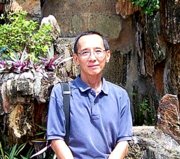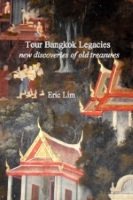- Home
- Bangkok Communities
- Koh Sarn Chao Community
Koh Sarn Chao Community
an urban oasis
By Eric Lim

Koh Sarn Chao Community is a 500-year old canal community in Taling Chan Bangkok that has preserved its architecture, way of life, handicraft and traditions in an area that’s virtually an island.
It’s like entering a different world that’s cool, green and insulated from the harsh concrete landscape outside. Step into this world with us as we take you on a tour of this old and very special place.
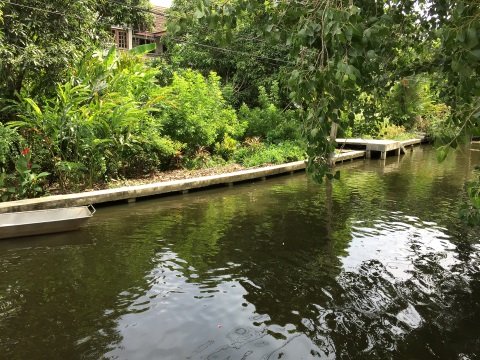
The Bang Sai Canal flowing past Wat Champa
Wat Champa
A drive through a narrow country lane brought us to Wat Champa, the start of our exploration of this old community. There are conflicting versions as to how old this temple is. One version states that Wat Champa was built in 1822 in the reign of King Rama II (1809 – 1824).
But others believe that the temple was built in the Ayutthaya era and underwent a massive restoration in the reign of King Rama III (1824 – 1851). One building at the far end of the temple grounds is different from all the rest of all the buildings.
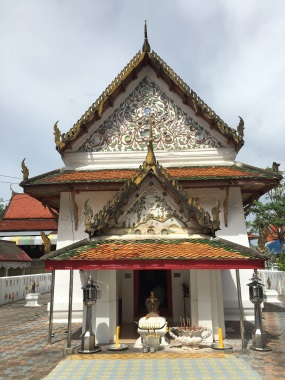
The ubosot or ordination hall
The gables of this building are studded with Chinese porcelain and the window frames are made of elaborately carved wood.
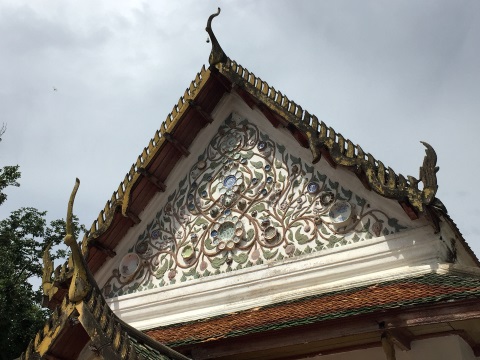
Gable studded with Chinese porcelain

Carved window frames
Behind this prayer hall is a pool of holy water that’s more than 100 years old. It never runs dry and the water is believed to cure illnesses.
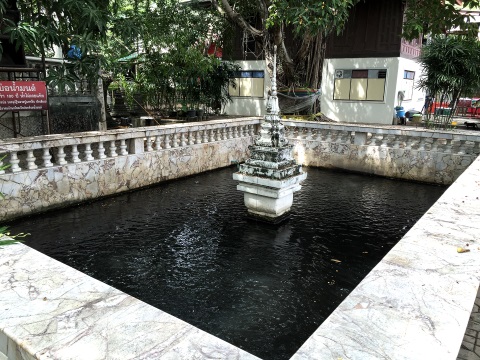
Pool of holy water
After touring the temple, we took a walk along the lane outside the temple walls and as we proceeded the lane got narrower and narrower until it became a footpath consisting of concrete slabs passable only to pedestrians, bicycles and motor-cycles.
Welcome to the Koh Sarn Chao Community. The houses here are built along a network of narrow canals leading into the major canals; Bang Sai and Bang Ramat. Movement within this community is either by boat or along the raised pedestrian footpath.

Footpath in Koh Sarn Chao
The community is bounded by highways and urban development all around but it’s inaccessible by road creating a verdant oasis filled with fruit plantations, hence the name koh or island. A glance at this satellite map will give you an idea of the environment here.
Map of the Koh Sarn Chao Community
Further down this country lane we came across a traditional Thai house with its gate open. We were unsure whether to enter, until a gentleman appeared and welcomed us in.
Khun Thaweesak Wangchan is the owner of Ban Sawangchan, the traditional Thai house. As we sat on the highly polished wooden floor of the sitting room, Khun Thaweesak told us more about the Koh Sarn Chao Community where he was born and grew up.

Ban Sawangchan - sitting room
He spoke passionately about his community. Old communities like these find it very hard to survive in an urban environment. The Koh Sarn Chao Community has much to offer in terms of its traditional architecture, handicraft, customs and delicious Thai desserts.
The relentless drive to redevelop the land to premium housing, condominiums and huge malls will soon squeeze these small traditional communities out. Some residents may choose to sell out and move to more accessible areas.
So as community leader, Khun Thaweesak hit on the idea of tourism; inviting small groups of tourists to learn more about this community, sample it’s way of life, handicraft and cuisine. Such activities will help sustain the community and in the process help preserve it.
Arrangements were made with the boat operators at the Lat Mayom floating market to bring visitors by boat to Koh Sarn Chao during the weekends.
Koh Sarn Chao Community - Ban Sawangchan
After the short briefing, we took a tour of this traditional Thai house that is bounded by canals. The area on the ground floor consists of the living room, dining room and a guest room. From the sitting room window, the watermark of the last great flood in 2011 is still visible. At that level, the living room was swamped then.
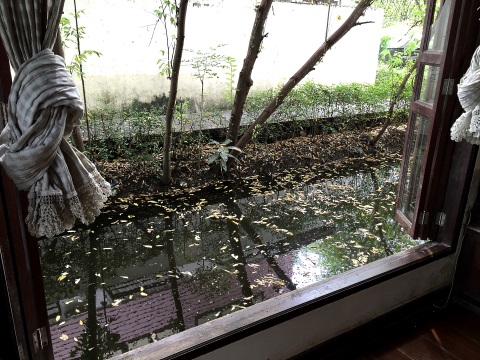
View from sitting room window – note the watermark on the opposite wall
The traditional dining area with food in common food containers reflects the harmony and unity in a family that dines together.

The dining area
The balcony in the guest room overlooks a canal to the rear of the house.
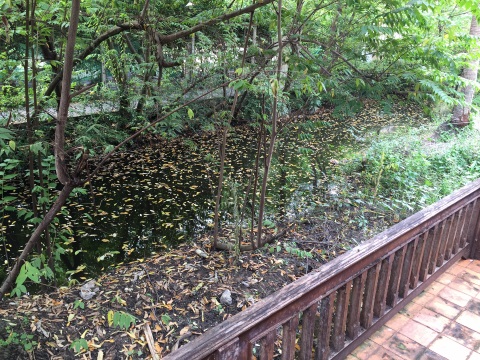
View from the balcony of the guest room

The guest room
Please note that certain rooms are closed to the public with a sign to indicate this. These are the living areas of the family, so please respect their privacy. For this reason, Ban Sawangchan is also called a Living Museum.
In the area upstairs two of the houses of Ban Sawangchan are joined by a common area. The living areas of the family are here. The areas open to the public are the display area for Khon masks and the sitting room.
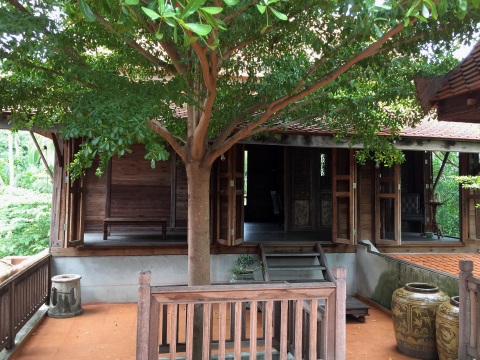
The open area upstairs
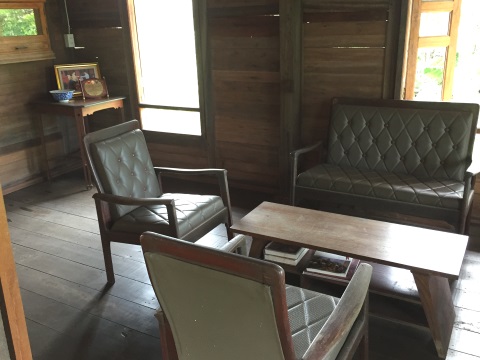
The sitting room upstairs

Wooden partition to the sitting room
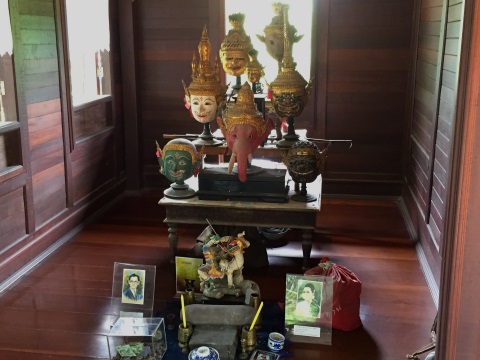
The Khon display
There’s a separate gate and stairway with direct access upstairs without having to go through the main door downstairs.

Gate to the stairs outdoors

Stairs outdoors
Banana stalk carving using a sharp stiletto-like knife to cut out elaborate designs is a specialty of Khun Thaweesak who acquired the skill from his father. He comes from a long line of artists and craftsmen.
During our tour upstairs, he gave short demonstration of this craft.

Khun Thaweesak peeling off the layers to get to the soft core
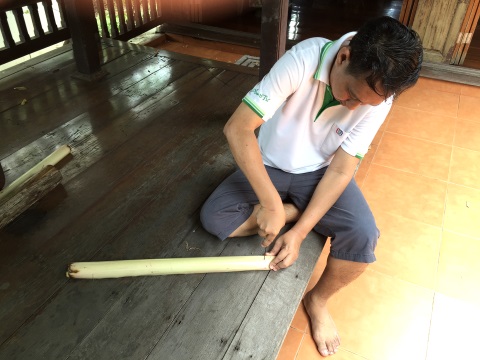

Cutting out the designs

The results
Koh Sarn Chao Community - Sarn Chao Por Chui
After touring Ban Sawangchan we proceeded to our next stop. Just before we reached a bridge spanning Khlong Bang Sai, we came across this shrine, Sarn Chao Por Chui, the Water God Shrine.
Taling Chan still retains a vast network of canals that drain into the Bangkok Noi and Bangkok Yai Canals eventually leading out to the Chao Phraya River. The Bang Sai and Bang Ramat Canals in the neighbourhood of Koh Sarn Chao form part of this network of canals.
In the old days when movement and trade were water-borne, such waterways were vital for the livelihoods of the farmers and traders. So it was only natural the local residents prayed at a Shrine for the God of Water or Sarn Chao Por Chui*
Every year in the 6th Lunar month there’s an annual festival to pay respects at this shrine as a form of thanksgiving. It is probably this shrine that contributed to the second part the name of this community, sarn chao – shrine.
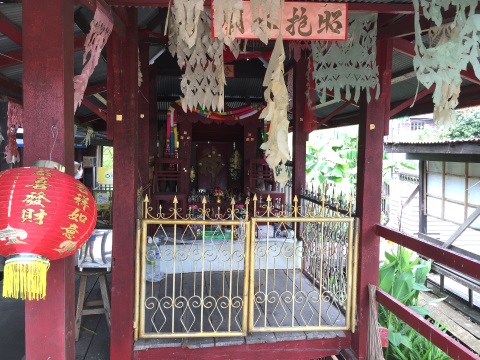
Sarn Chao Por Chui
* sarn – shrine, chao por – a god or male deity, chui - water in the Teochew (Chaozhou) dialect which the majority of the ethnic Thai Chinese speak.
Ban Kreung Hom or Perfumery House
After passing the shrine, we crossed the bridge at the confluence of the Bang Sai and Bang Ramat Canals and proceeded to our next stop. We passed a grocery shop along the way to ask for directions.
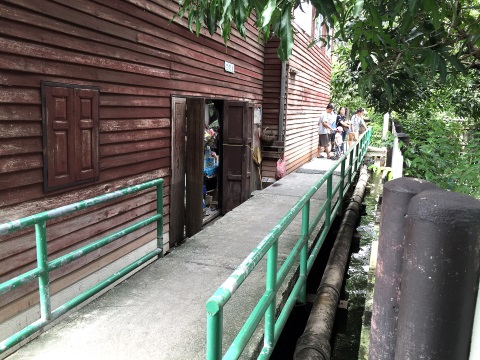
A traditional grocery shop along the way
In a closely-knit community like the Koh Sarn Chao Community, everybody knows where everybody else stays. The directions took us to this house with a beautiful garden, we had to cross a bridge spanning a narrow canal to get to the house.

Entrance to Ban Kreung Hom
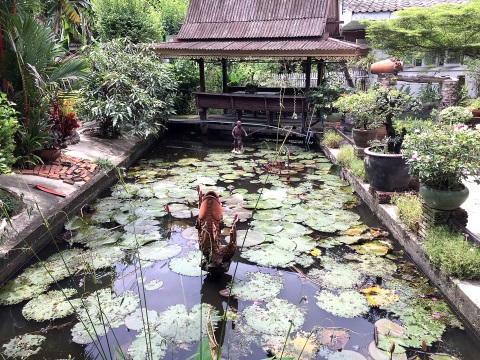
Crossing the canal
Ban Kreung Hom is the home of Khun Thaweesak’s younger sister and it deals with perfume and powder made from natural material. In addition, this place makes beautiful garlands from scented powder beads!
In this craft, powder is mixed with lime, water and flower scents to produce a thick creamy paste which is put in a cone and squeezed onto a prepared garland of strings. When the powdered beads dry, these are the results, exquisite Thai handicraft.
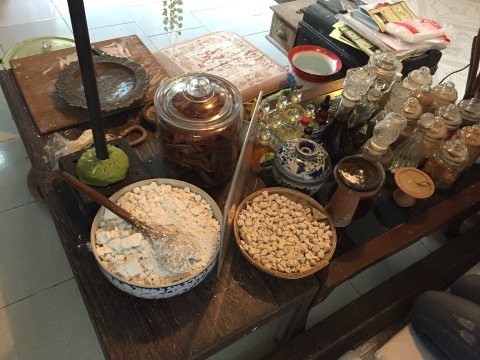
The ingredients
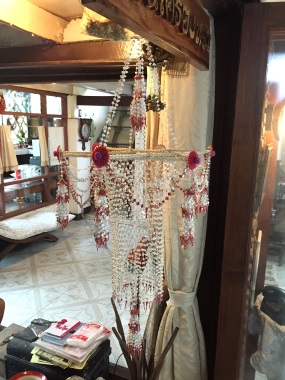

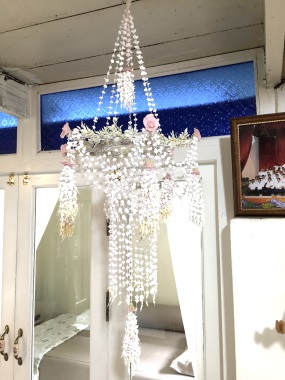
The beautiful handicraft
There’s a little shop in the garden selling some of the cosmetic products of Ban Kreung Hom and a quaint little café where you can sit down and enjoy your special brew. Take a walk around the garden, the place is an oasis of peace and serenity.

Small shop selling perfumes
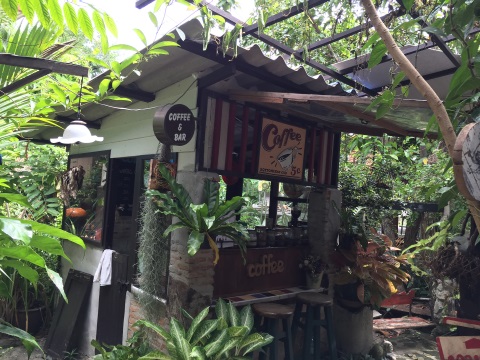
Coffee break
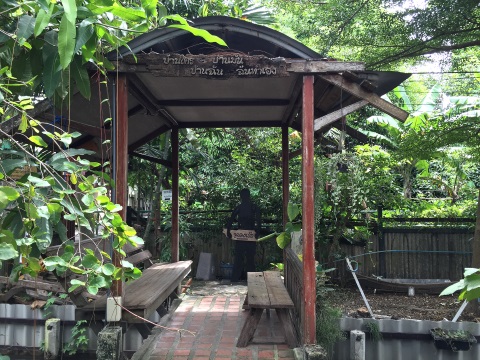

An oasis of peace and serenity
After two forms of exquisite Thai handicrafts, it was time for some delicious Thai desserts. So down the path we went seeking out Granny Berm’s home that’s famous for Thai desserts.
Along the way we stopped at this stall selling home-made lod chong. This Thai delicacy is made from grinding uncooked rice, water is added to turn it to a paste. The mixture is boiled with bai tei or pandan leaves to give it the flavour and colour.
The jelly mixture is poured on a sieve to make the little strips. Coconut milk and brown sugar are added to produce a sweet dessert. We found out from some residents passing by that Granny Berm’s home wasn’t open that day so this dessert compensated for it.

Lod chong – a sweet Thai dessert
Our visit to the Koh Sarn Chao Community gave us a chance to visit a community that is very different from the urban surroundings we are used to, and see their homes, their way of life, customs, handicraft and sample their delectable desserts.
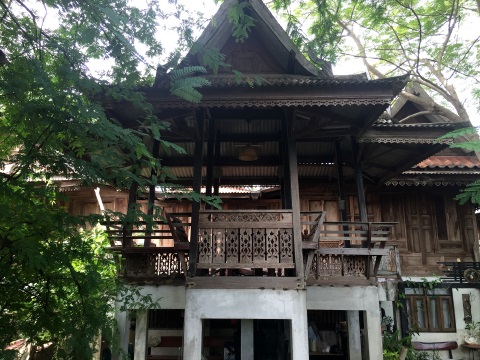
Traditional Thai house available for homestay
We are deeply grateful to Khun Thaweesak Wangchan for his hospitality and the information provided during our visit and wish the Koh Sarn Chao Community all the best in its efforts to preserve its cultural heritage.
Map of the Koh Sarn Chao Community
Please refer to the satellite map of Koh Sarn Chao Community showing the location of the various places visited.
Or click on this link to view the map
The map below shows the location of Koh Sarn Chao Community and how to get there by car.
Or click on this link to view the map
How to get there
BY MRT Blue Line/taxi
Take the MRT Blue Line to BL4 Bang Khon Non Station and take a taxi to Wat Champa. from the temple, you'll have to walk in to the community.
By car
Take the Borommaratchachonanni Road toward Nakhon Pathom – turn left to Phutthamonton Sai 1- turn left again at Phutthamonthon Sai 1 Soi 24 (it’s shown as Thanon Chim Phli on the map)
Follow this narrow soi till you get to Wat Champa. Parking is available in the temple grounds.
By boat
From the pier at the Lat Mayom Floating Market – fare 50 baht per head, the trip takes about 30 minutes.
Contact
Facebook/Kohsarnchao.community
Tel: Thawee Wangchan 087 – 036 – 6322
Visitors can call in advance for homestay facilities, banana stalk carving or Thai dessert classes.
Opening times
Weekends from 9 am – 5 pm. Admission is free. Visitors are welcome to leave a donation for the maintenance of the place.
For more Bangkok Communities.
Other attractions nearby
Khlong Lat Mayom Floating Market
My Journey through Thailand Part I The First Steps
This is my second e-book and the first in the series of travel journals on my trips to explore the various provinces in Thailand. This edition, which covers my travels from late 2009 to mid-2013, will guide you to historical sites, cultural monuments and exquisite Thai handicraft, across a vast spectrum of cultural and ethnic diversity.
You can have a virtual tour with this e-guide book or take the first steps yourself in this journey through Thailand.
My Kindle e-book

Search Tour Bangkok Legacies with DuckDuckGo
My Journey through Thailand
Part I The First Steps
My Kindle edition

My Smashwords edition



